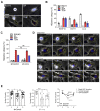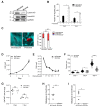Reduced Lamin A/C Does Not Facilitate Cancer Cell Transendothelial Migration but Compromises Lung Metastasis
- PMID: 34069191
- PMCID: PMC8157058
- DOI: 10.3390/cancers13102383
Reduced Lamin A/C Does Not Facilitate Cancer Cell Transendothelial Migration but Compromises Lung Metastasis
Abstract
The mechanisms by which the nuclear lamina of tumor cells influences tumor growth and migration are highly disputed. Lamin A and its variant lamin C are key lamina proteins that control nucleus stiffness and chromatin conformation. Downregulation of lamin A/C in two prototypic metastatic lines, B16F10 melanoma and E0771 breast carcinoma, facilitated cell squeezing through rigid pores, and reduced heterochromatin content. Surprisingly, both lamin A/C knockdown cells grew poorly in 3D spheroids within soft agar, and lamin A/C deficient cells derived from spheroids transcribed lower levels of the growth regulator Yap1. Unexpectedly, the transendothelial migration of both cancer cells in vitro and in vivo, through lung capillaries, was not elevated by lamin A/C knockdown and their metastasis in lungs was even dramatically reduced. Our results are the first indication that reduced lamin A/C content in distinct types of highly metastatic cancer cells does not elevate their transendothelial migration (TEM) capacity and diapedesis through lung vessels but can compromise lung metastasis at a post extravasation level.
Keywords: cancer metastasis; chemotaxis; diapedesis; epigenetics; extravasation; imaging; nucleus.
Conflict of interest statement
The authors declare no conflict of interest.
Figures







Similar articles
-
Frontline Science: Elevated nuclear lamin A is permissive for granulocyte transendothelial migration but not for motility through collagen I barriers.J Leukoc Biol. 2018 Aug;104(2):239-251. doi: 10.1002/JLB.3HI1217-488R. Epub 2018 Mar 30. J Leukoc Biol. 2018. PMID: 29601096 Free PMC article.
-
Effect of lamin-A expression on migration and nuclear stability of ovarian cancer cells.Gynecol Oncol. 2019 Jan;152(1):166-176. doi: 10.1016/j.ygyno.2018.10.030. Epub 2018 Oct 29. Gynecol Oncol. 2019. PMID: 30384980
-
Consequences of Lamin B1 and Lamin B Receptor Downregulation in Senescence.Cells. 2018 Feb 6;7(2):11. doi: 10.3390/cells7020011. Cells. 2018. PMID: 29415520 Free PMC article. Review.
-
Lamin B1 loss promotes lung cancer development and metastasis by epigenetic derepression of RET.J Exp Med. 2019 Jun 3;216(6):1377-1395. doi: 10.1084/jem.20181394. Epub 2019 Apr 23. J Exp Med. 2019. PMID: 31015297 Free PMC article.
-
Laminopathy-causing lamin A mutations reconfigure lamina-associated domains and local spatial chromatin conformation.Nucleus. 2018 Jan 1;9(1):216-226. doi: 10.1080/19491034.2018.1449498. Nucleus. 2018. PMID: 29517398 Free PMC article. Review.
Cited by
-
Advances in research on the relationship between the LMNA gene and human diseases (Review).Mol Med Rep. 2024 Dec;30(6):236. doi: 10.3892/mmr.2024.13358. Epub 2024 Oct 18. Mol Med Rep. 2024. PMID: 39422026 Free PMC article. Review.
-
Elevated Levels of Lamin A Promote HR and NHEJ-Mediated Repair Mechanisms in High-Grade Ovarian Serous Carcinoma Cell Line.Cells. 2023 Feb 27;12(5):757. doi: 10.3390/cells12050757. Cells. 2023. PMID: 36899893 Free PMC article.
-
Insights into the mechanobiology of cancer metastasis via microfluidic technologies.APL Bioeng. 2024 Jun 3;8(2):021506. doi: 10.1063/5.0195389. eCollection 2024 Jun. APL Bioeng. 2024. PMID: 38841688 Free PMC article. Review.
-
Lung endothelium exploits susceptible tumor cell states to instruct metastatic latency.Nat Cancer. 2024 May;5(5):716-730. doi: 10.1038/s43018-023-00716-7. Epub 2024 Feb 2. Nat Cancer. 2024. PMID: 38308117 Free PMC article.
-
ICAM-1 on Breast Cancer Cells Suppresses Lung Metastasis but Is Dispensable for Tumor Growth and Killing by Cytotoxic T Cells.Front Immunol. 2022 Jul 11;13:849701. doi: 10.3389/fimmu.2022.849701. eCollection 2022. Front Immunol. 2022. PMID: 35911772 Free PMC article.
References
Grants and funding
LinkOut - more resources
Full Text Sources
Molecular Biology Databases

